Almanac: An Ode To Ice

Fragile daggers of newly-forming ice begin to cover a patch of open water on Lake Warner last week. Photo: Stephen Braun
Ice has had a tough time forming on local bodies of water this so-called winter. It has repeatedly formed, and then melted, in the shallow parts of Lake Warner and Puffers Pond, the two watery places I most often frequent. Last Thursday there were still areas of open water on Lake Warner, although we are heading into a cold snap, which may, finally, put a solid cap on our local ponds.

Ice can certainly be a bother—or downright dangerous—as anyone who tried to drive on the ice- glazed roads last Wednesday can attest. But ice can also take on a myriad of beautiful forms, such as the feathery lace on window panes, marble-like swirls on the surfaces of frozen ponds and streams, and in delicate columns emerging as damp earth freezes.
Ice—and the water from which it forms—is also deeply weird. If it were not for this weirdness we might not be here to muse upon its peculiar properties.
Most things, liquid or solid, shrink when they cool. That’s because as the molecules from which they are made lose energy and slow their incessant vibration, they can pack together more tightly. This is also true for most liquids. As they cool, these liquids become more and more dense until they freeze, at which point they become denser still and drop to the bottom of the liquid. This is the case, for example, with carbon dioxide: frozen carbon dioxide (i.e., dry ice) not only sinks to the bottom of a glass of water, it sinks to the bottom of a glass of liquid carbon dioxide.
Water, however, doesn’t follow this script. When liquid water is cooled, it contracts and becomes denser than you might expect until it reaches 39 degrees Fahrenheit. As the temperature drops below that point, a strange thing happens: the water starts to expand slightly, becoming less dense. When the water freezes it expands even more—by about 9% compared to 39-degree water.
This strange behavior is due to the shape of water molecules. You may recall from an old chemistry class that an H2O molecule looks like a Mickey Mouse head, with a large oxygen atom for a face and two smaller hydrogen atoms as ears. The oxygen atom is slightly negatively charged and the hydrogens are slightly positively charged, so water molecules have a polarity. They’re a bit like extraordinarily tiny magnets. The negative end of one molecule tends to be attracted to the positive end of other water molecules—a relatively weak attraction called a hydrogen bond.
In warm water the molecules are dancing about with too much energy for the hydrogen bonds to have much effect. But as the water cools, the molecules start to respond to each other, linking together. Below 39 degrees F the hydrogen bond interactions have the effect of “fluffing up” the water making it less dense. Then, below 32 degrees, all those molecules organize themselves, and their magnetic poles, into configurations that require a minimum about of energy. That structure takes up more space than warm liquid, hence ice floats.
Not only is this extremely valuable for ice skaters and ice fishermen, it turns out that life itself might not have evolved if ice did not float. Think what would happen if liquid water behaved like liquid carbon dioxide: whenever ice formed, it would sink and resist melting on the bottom of lakes and oceans. The ice would slowly accumulate until the entire lake or ocean was solid, with only a thin layer of liquid appearing in summer or in southerly locations. This would prevent all sorts of vital ecologic and geologic processes from happening and might well have prevented the evolution of life itself, although nature is nothing if not clever, so who knows? Still, a world with mostly-frozen bodies of water would pose far greater challenges to the evolution of complex organisms than our own wonderfully fluid planet.
So that’s my little Ode to Ice. But I want to share one more ice-related thing. I was walking around Atkins Reservoir a couple of weeks ago on a mild day when I spotted a favorite pattern in the ice near shore.

I call these patterns “ice neurons” because that’s what they remind me of. They’re formed when something small, such as a pine cone, small twig, or ball of ice, falls onto warmish, mushy ice. The resulting divot allows water to drain across the nearby ice, carving channels resembling the branching of river tributaries, trees, or the cell bodies of neurons. I love these kinds of reminders that the laws of physics work at all size scales in the universe and that, therefore, you can get very similar shapes and patterns in things with vastly different dimensions such as billowing summer clouds and the clouds of dust and gas in interstellar nebula, or the spirals of a hurricane and the spirals of entire galaxies. I find the universality of the laws of physics deeply comforting, although I’m hard pressed to say exactly why.
A Note To Readers
I’ve been writing Almanac weekly for almost a year now. It’s been great fun, and I’m heartened by the positive responses from readers. The every-week cadence, however, is challenging, especially in winter when so many critters and plants are dormant. From here on, therefore, I’ll be writing when inspiration strikes rather than forcing myself to produce something every week. By “going with the flow” this way I hope to retain a freshness and enthusiasm in the columns that might wither under the pressure of an artificial schedule. Nature seems to abhor both vacuums and predictability, so I’ll take my cue from Her and see what happens.
Almanac is a regular Indy column of observations, musings, and occasional harangues related to the woods, waters, mountains, and skies of the Pioneer Valley. Please feel free to comment on posts and add your own experiences or observations.

I will so miss your weekly column Steve. It is definitely one of my favorites in the Indy. I look forward to any new articles you write, and will spend each week going back to the previous ones. Thank you so much for imparting your wisdom and excellent eye for nature.
I go directly to your column every week, my first read. I love your writing and the information you share. Thank you for your huge effort to keep this appearing for so many weeks. I look forward to the occasional post in the future.
Molly Turner
Like Molly, your column is the first one I read each week. May Mother Nature inspire you in the New Year.
Love every one of your articles, Steve. Great thanks on ongoing appreciation while I look forward to when Mother Nature and time returns you to these pages once again. Ah, Spring!
Hear, hear, SB!
But now we can look forward to “Almanac Surprise” – or maybe “Almanac a la Friends Meeting”? – where you only need to write when “the light” shines upon you!
— RK
Steve, may inspiration hit often and hard! I look forward to your musings, photos, and on top of that, some pretty interesting information!
In winter, many Earthlings’ thoughts turn to ice-skating, where water’s density-as-a-function-of-temperature plays a critical role in both ice’s slipperiness, and also in its location atop of the pond (rather than at the bottom).
But on Jupiter (and many other planets) it rains ammonia , which (like water) also has an (electric) dipole moment, so I wonder* whether any (hypothetical) Jovians’ thoughts turn the same way?
And on mythical planet Mendeleev (rumored to have been visited by Gen. J. D. Ripper of Dr. Strangelove fame) it rains pure ethyl alcohol (yet another polar liquid), so similar questions** arise there….
[*Unlike water, liquid ammonia seems to have a monotone density-as-a-function-of-temperature profile, and solid ammonia at -80C appears to be quite a bit denser than liquid ammonia at slightly higher temperature, so I’d venture the Jovian ammonia-ice-hockey team can also swim! But if a little water is mixed in with the ammonia, then things get more interesting….
**Ditto for the liquid ethanol density-as-a-function-of-temperature profile, but the density of solid ethanol remains elusive, so predictions yet about the swimming ability of Mendeleevian ethanol-ice-hockey players….]